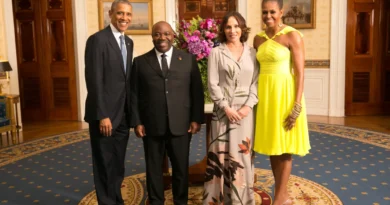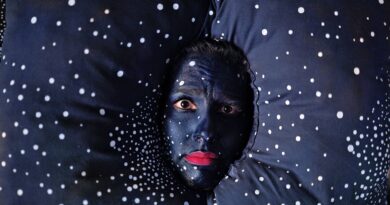The oil and the left in Latin America
SERGIO NAVAS
Today, the world is burning more oil than ever before. Although the green agenda and renewable energies are advancing, the reality is that the pandemic and the war in Ukraine have delayed the energy transition. The peak of fossil fuel consumption is now expected for 2032. In addition to Covid and Ukraine, the trade war against China has further contributed to the 'deglobalizing' scenario, pushing for a geopolitical realignment.
The need to build reliability in supply chains and access to raw materials once again put a forgotten Latin America on the map. As an example, in July the EU-CELAC (European Union with Latin America and the Caribbean) summit was revived after 8 years. The West wants to put the region's resources on its side, no closer to China. However, before talking about tomorrow's lithium and green hydrogen, we must look at today's oil. The five largest producers in Latin America have leftist governments, but their political reality and their relationship with black gold is quite different.
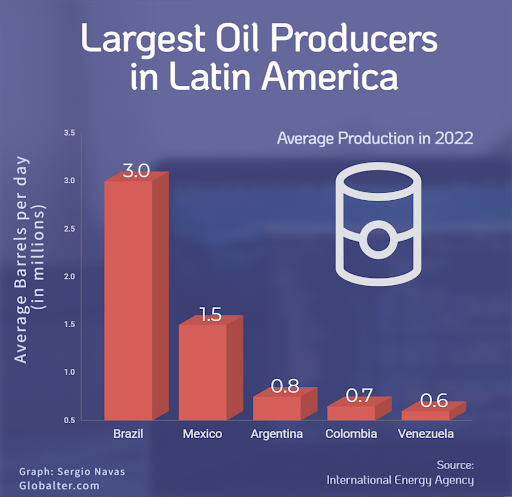
#5 Venezuela (600.000 barrels per day)
It has the largest proven reserves in the world, but it is about to complete a decade of economic collapse. Chavismo has ruled since 1999 and became so dependent on oil that the industry's income came to represent 80% of the country's exports in 2009. Nationalized crude that leveraged social spending and facilitated leftist governance.
Venezuela came to produce 3 million barrels per day in 1999, but in 2022 it only produced an average of 600.000. Consequence of the economic sanctions imposed by the United States, internal corruption, and in general the social collapse that the country is experiencing, forcing 6 million of its citizens to emigrate.
Recently, the war in Ukraine urged the White House to secure other sources of oil, and that suddenly made Nicolás Maduro less of a "dictator" in the eyes of the West. The US withdrew support for the parallel 'government' in which they tried to set up opposition figure Juan Guaidó and the US oil company Chevron was allowed to resume operations. Production is slowly rising. The hope is that the talks between Chavismo and the opposition will advance towards fair elections and more sanctions will be lifted to revive the industry. It is estimated that Venezuela could recover its maximum production in 7-10 years.
#4 Colombia (650.000 barrels per day)
The United States' longtime ally has a left-wing government for the first time. Gustavo Petro won in 2022 with 51.5% of the vote in a close second round, facing right-wing 'outsider' Rodolfo Hernández (48.5%), who was initially independent but later was joined by the traditional parties in their effort to stop the left-wing ghost.
Colombia is the country with the fewest oil reserves on this list, barely 7 years old, and its president says that he is not going to grant new exploration contracts. Petro's ambitious environmental agenda calls for a political brake on the extraction of fossil fuels, promoting sectors such as tourism and agriculture instead. That more progressive, environmentalist left has foreign capital and risk rating agencies nervous. The question is whether Colombia will be able to replace 40% of its exports, now coming from oil, in such a short time.
Gustavo Petro seeks space as an environmentalist on international stages and promotes ideas such as debt swaps for climate action. This is forgiving debt so that emerging countries use that money in green actions that benefit the planet. The rich countries have shown intentions, but not concrete realities for that to happen. Meanwhile, Petro promises to respect all current and awarded contracts, but the failure to explore new fields raises doubts about the country's energy sovereignty.
#3 Argentina (750.000 barrels per day)
President Alberto Fernandez has found one of his few economic reliefs in the increasing production of fuels from the monumental Vaca Muerta field. There is so much gas and oil that Exxon, Chevron, Shell and all the big multinationals are there. Also the state company YPF, which hopes to continue growing with Vaca Muerta and double its production in the coming years, thus providing more foreign currency for Argentina.
In October the presidential elections will define the course of the country. The economy, already battered since the beginning of the century, is going through a particularly difficult moment: a shortage of dollars, a strong devaluation of the peso, and inflation of 110% in 2022. With such a dark scenario, it seems difficult for the left to maintain power, although we must remember that they won 4 of the last 5 elections. Mauricio Macri was the only right-winger who stood in the way (2015-2019), but his government ended up as the most unpopular of all.
The government candidate, from kirchnerismo/peronismo, is Sergio Massa. He is the Minister of the Economy and he is not a leftist, which is why they are trying to win votes with him in the political center. However, being the face of continuity seems too great a burden in a country on the brink of economic collapse. On the right is Patricia Bullrich, heiress to macrismo, and on the radical and extravagant right is Javier Milei, a kind of populist 'outsider' who promises to dollarize the economy.
A self-described 'libertarian liberal' and 'market anarchist', Milei is outspokenly anti-China and an admirer of Donald Trump. He is committed to drastically reducing the state, dollarizing, and eliminating the central bank. It would be a political earthquake with historical consequences. In the primary elections in August, the three forces had practically a tie, so the deck is open and between Massa, Bullrich and Milei will be the presidency. Who will go to a probable second round and who is elected will be key to defining whether Argentina, with all its natural resources, approaches the BRICS or the dollars.
#2 Mexico (1.5 million barrels per day)
In contrast, the Mexican economy is experiencing a positive moment. As shown by the so-called 'superpeso', which is the recent appreciation of the Mexican peso against the dollar. Despite the problems of violence and drug trafficking, there are large flows of capital arriving, since Mexico is one of the biggest beneficiaries of the trade war against China. 'Nearshoring' (offshoring to a nearby country) and 'derisking' (reducing certain lines of business to avoid financial risks) are the strategies of the US economy to take industrial production to neighboring places and increase trade with friendly countries.
Andres Manuel Lopez Obrador, AMLO, is the most popular president on the list. Now in his fifth year in office, he has close to 70% favorable opinion, but in Mexico there is no re-election and it is yet to be defined who will carry his flag in next year's voting. The favorite is Claudia Sheinbaum, who resigned as mayor of Mexico City to launch herself. She is closer to the political center and would be the first female president. She has extensively studied climate change and has a green agenda that wants to steer Mexico away from oil.
And it is that the oil industry is not doing well there. Pemex, the state hydrocarbons company, is one of the most indebted in the world. For years the Mexican state has allocated large resources to support its financial commitments, but the next government may not be so generous. An increasing risk of default (non-payment) is discussed. Mexico's current production, of 1.5 million barrels per day, is far from its record production in 2004, when it reached 3.4 million.
#1 Brazil (3 million barrels per day)
Lula's third government (first 2003-2007, second 2007-2011) is just beginning, but it already seems to have some returns by positioning itself as a protector of the Amazon jungle. In clear contrast to the extreme right of his predecessor Jair Bolsonaro, a climate change denier who allowed a precipitous increase in deforestation levels.
Lula is green but not so green as to renounce pragmatism and oil revenues. The plan to search for deposits in the Amazon river delta has already been rejected by the regulatory agency, and has left serious divisions among its ministers. The one from the Environment is against exploring due to possible risks to the ecosystem, the one from Mines and Energy believing in the correct and careful exploration.
Lula settled the dispute and left things in the hands of future technical studies: "If exploiting that oil is a problem for the Amazon, clearly it will not be exploited, but I see it as difficult, because it is 530 kilometers from the Amazon." Another example was offered at the recent summit of countries with the Amazon rainforest, where Brazil refused to include anti-oil positions. Lula seems green, yes, but the economy and social spending come first.
The South American giant is today the eighth largest global producer. It has stood out thanks to the discoveries in the “pré-salt”, located under the sea, near Rio de Janeiro and São Paulo. There, Brazil guarantees the supply of oil for its more than 200 million inhabitants and a growth in exports, with more and more barrels going to China.
Extra Mention
Mention should be made of Guyana, a small country in northern South America that gained its independence from the United Kingdom in 1966. It is also governed by a left-wing party and its recent oil discoveries are among the largest in the world in decades. Production is picking up scale, 400.000 barrels a day in 2022. It remains to be seen how they will manage that wealth in the nation of just 800.000 people. It is expected that by 2025 Guyana will be one of the top 5 producers in the region, and by 2030 one of the 20 largest in the world.



